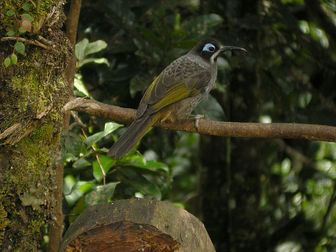Belford's Melidectes

Original source: markaharper1
Author: markaharper1
The Belford's Melidectes is classified as Least Concern. Does not qualify for a more at risk category. Widespread and abundant taxa are included in this category.
The Belford's Melidectes (Melidectes belfordi) is a species of bird in the Meliphagidae family. It is found in Indonesia and Papua New Guinea. Its natural habitat is subtropical or tropical moist montanes. References - * BirdLife International 2004. Melidectes belfordi. 2006 IUCN Red List of Threatened Species. Downloaded on 26 July 2007. Stub icon This article about a honeyeater is a stub. More
the Belford's Melidectes aggressively defended the flowers of the terrestrial root parasite Mitrastemmaa from the Ornate Melidectes. One species, the Long-bearded Melidectes, is considered to be threatened with extinction due to habitat loss, and it is therefore listed as vulnerable by the IUCN. The Bismarck Melidectes is considered to be near threatened due to forest clearance on New Britain. Many of the other species of melidectes are restricted range species, occupying small global ranges; in many cases single mountain ranges. More
For the purposes of our bird news services, Belford's Melidectes is classed as Ungraded: species which are unlikely to appear as wild birds in Britain or Ireland hide section Most recent photos of Belford's Melidectes (1) Kumul Lodge, Hagen, Papua New Guinea Kumul Lodge, Hagen, Papua New Guinea05/10/2006 Kumul Lodge, Hagen, Papua New Guinea 05/10/2006 View all pictures of Belford's Melidectes View all pictures of Belford's Melidectes show section External Links (0) We More
Belford's Melidectes etc were visiting all day. The lodge has a system of trails which you can wander by yourself. They are not marked, but the area is not so large you could get lost, although I tried hard to do this. Actually many of the birds can be seen along the entrance driveway. More
Belford's Melidectes, Common Smoky Honeyeater, and occasionally a male Regent Whistler—how dapper is he! The normally secretive Rufous-naped Whistler pottered to and fro, providing a never-ending scene of fascination. Cameras continued to click, the rain puttered on, and another break saw a White-winged Robin at the nest. Much to everyone's delight, a speckled dasyure—one of New Guinea's elusive carnivorous marsupials—arrived at the feeder and foraged assiduously for maggots buried in the table of mosses that now covered the feeder. More
Family : Meliphagidae
Genus : Melidectes
Species : belfordi
Authority : (De Vis, 1890)

